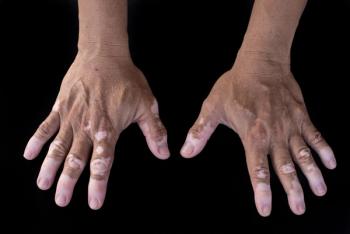
A New Combination Therapy Looks Promising for Treating Adult Vitiligo
As researchers continue to explore more effective solutions, combining platelet-rich plasma (PRP) with fractional laser therapy has gained increasing attention.
Combining fractional laser treatment with platelet-rich plasma (PRP) could offer a more safe and effective option for adults with stable vitiligo who haven’t responded to standard therapies, according to results from a recent study published in the
Vitiligo is a long-term skin condition that causes white patches to form when the skin loses its pigment cells, called melanocytes. These patches can change a person’s appearance and their well-being.
Although many treatments exist—ranging from topical therapies to phototherapy and surgery—many patients, particularly those with stable or treatment-resistant vitiligo, fail to see meaningful improvement.
As researchers continue to explore more effective solutions, combining platelet-rich plasma (PRP) with fractional laser therapy has gained increasing attention, according to the study.
It was shared in the study that fractional lasers, especially ablative types that use heat or cold for tissue removal—such as carbon dioxide (CO₂) lasers—are thought to help stimulate pigment restoration through immune activation and improved absorption of light-based and topical therapies.
PRP is made of the patient’s own platelets and contains growth factor proteins that aid in skin regeneration and cellular repair.
Previous studies suggest that PRP, when used alongside other treatments, can enhance results and reduce side effects.
However, few studies have focused specifically on the combination of PRP and fractional laser therapy.
To address this gap, researchers conducted a systematic review and meta-analysis to evaluate the safety and effectiveness of using both therapies together in adults with vitiligo.
In the study, researchers followed Preferred Reporting Items for Systematic Reviews and Meta-Analyses (PRISMA) guidelines, which is a set of guidelines that helps authors transparently report systematic reviews and meta-analyses.
The process involved a comprehensive search of PubMed, EMBASE, the Cochrane Central Register of Controlled Trials and Web of Science for studies published up to January 1, 2025, using terms including “vitiligo,” “platelet-rich plasma,” “PRP” and “fractional laser,” with no language restrictions.
Two reviewers screened all studies and resolved any disagreements through discussion. To be included, studies had to be randomized controlled trials involving patients with vitiligo treated with PRP combined with fractional lasers and report at least one key outcome.
Data collected included patient demographics, treatment details, number of sessions, follow-up duration, repigmentation outcomes, satisfaction scores, physician assessments and side effects.
Study quality was also assessed using the Cochrane risk-of-bias tool and the modified Jadad scale, with scores of 4 or higher considered high quality.
Out of seven studies involving 366 patients comparing different treatments—including monotherapy, topical drugs, sun exposure and fractional lasers with narrowband ultraviolet B (NB-UVB)—the combination therapy significantly improved repigmentation and patient satisfaction.
The average grade of repigmentation was higher in the combination group (mean difference [MD] = 1.58), and patient satisfaction scores were also significantly better (MD = 1.87).
In addition, the combination therapy reduced the number of patients who showed no improvement.
In terms of side effects, there was no significant difference between the combination group and the control groups, and all reported side effects—such as mild pain, burning, crusting and hyperpigmentation—were temporary and resolved without special treatment.
Of the 42 studies initially identified, only seven met the strict inclusion criteria after screening and quality assessment.
These studies, published between 2017 and 2024, were rated high quality based on the modified Jadad scale, and publication bias appeared low.
Subgroup analyses confirmed that PRP combined with fractional lasers outperformed treatments such as fractional lasers alone or sun exposure alone, but showed no significant difference compared to PRP-only groups in some outcomes.
Sensitivity review also confirmed the consistency and reliability of these findings, strengthening the notion that the combination treatment offers a more effective and well-tolerated option for patients with vitiligo.
According to the authors, this meta-analysis is the first to thoroughly evaluate combining PRP with fractional lasers as a treatment for vitiligo.
A key strength is that the included studies were high quality, and this review highlights a potential alternative for patients with vitiligo, a condition with few consistently effective treatments.
The combination therapy also appears to enhance melanocyte activity and skin healing, with both PRP and lasers playing unique roles.
However, there are important limitations.
For example, most included studies were small, short-term and conducted only in Egypt and India, which limits the reach of the results to other populations.
Also, not all studies clearly described their methods for randomization or blinding, which could result in possible bias.
The study also lacked data on cost-effectiveness and long-term outcomes.
Lastly, while the combination therapy showed better results than many controls, it was not always significantly more effective than PRP alone, which raised concerns among researchers about the true benefit of adding laser treatment.
Future research is suggested on examining diverse patient populations, longer follow-up periods and standardized protocols for PRP preparation and laser use.
Authors also suggest future trials compare PRP-only, laser-only and combination groups directly to clarify the most effective and efficient approach.
Newsletter
Get the latest industry news, event updates, and more from Managed healthcare Executive.





















































